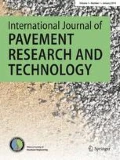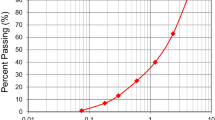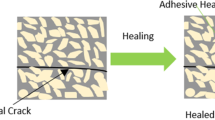Abstract
Moisture damage is a critical problem of asphalt pavements. Some factors affecting the moisture sensitivity of asphalt mixtures include bitumen properties, air void content, and the type of anti-stripping additive. This study investigated the use of nano-silica for improving the properties of different bitumens and to increase the moisture resistance of asphalt mixtures at different traffic loading conditions. Two types of bitumen (60–70 and 85–100 pen grade) were modified with various percentages of nano-silica (0, 0.2, 0.4, 0.7, and 0.9% by the weight of the bitumen), and physical and rheological tests were conducted to determine the optimum nano-content. Then, the optimal content was used to prepare asphalt mixtures at three different air void contents (4, 5, and 6%) to simulate the heavy, medium, and low traffic loading conditions. Indirect tensile strength (ITS) and compressive strength tests were performed on the specimens in dry and wet conditions, and the effect of air void content and the type of bitumen on the moisture sensitivity and compressive strength of unmodified and nano-silica-modified asphalt concrete was investigated. The results showed that nano-silica improved the moisture sensitivity of asphalt mixtures with 60–70 and 85–100 pen grade bitumens at all air void contents and the effect of nano-silica was higher on the moisture sensitivity of asphalt mixtures with 60–70 than 85–100 pen grade bitumen.
Similar content being viewed by others
References
A.E.A.E.-M. Behiry, Laboratory evaluation of resistance to moisture damage in asphalt mixtures, Ain Shams Eng. J. 4 (3) (2013) 351–363.
F. Xiao, W. Zhao, T. Gandhi, S. N. Amirkhanian, Influence of antistripping additives on moisture susceptibility of warm mix asphalt mixtures, J. Mater. Civ. Eng. 2010. 22(10) 1047–1055.
B.M. Kiggundu, F.L. Roberts, Stripping in HMA mixtures: State-of-the-art and critical review of test methods, National Center for Asphalt Technology Auburn, AL, USA, 1988.
P.S. Kandhal, Moisture susceptibility of HMA mixes: identification of problem and recommended solutions. Quality Improvement Publication (QIP) No. 119. National Asphalt Pavement Association, Washington DC, USA, December 1992.
S. Kim, B.J. Coree, Evaluation of hot mix asphalt moisture sensitivity using the Nottingham asphalt test equipment, Iowa State University, Center for Transportation Research and Education, IA, USA, 2005.
R.L. Terrel, T. V. Scholz, A. Al-Joaib, S. Al-Swailmi, Validation of binder properties used to predict water sensitivity of asphalt mixtures (with discussion), J. Assoc. Asphalt Paving Technol. 62 (1993) 172–222.
H. Plancher, S. Dorrence, J. Petersen, Identification of chemical types in asphalts strongly adsorbed at the asphaltaggregate interface and their relative displacement by water [Moisture damage to roads], Energy Research and Development Administration, Laramie Energy Research Center, Laramie, WY, USA, 1977.
W.G. Craig, Variables of the Static Asphalt Stripping Test, Proceedings, The Assocation of Asphalt Paving Technologists, Transportation Research Board, Washington DC, USA, Vol. 27, 1958, pp. 519.
D.N. Little, A. Bhasin, Exploring mechanism of H ealing in asphalt mixtures and quantifying its impact, in Self healing materials, Springer, Dordrecht, Netherlands, 2007, p. 205–218.
J. Ekblad, R. Lundström, E. Simonsen, Water susceptibility of asphalt mixtures as influenced by hydraulically active fillers, Mater. Struct. 48 (4) (2015) 1135–1147.
B.V. Kok, M. Yilmaz, The effects of using lime and styrene-butadiene-styrene on moisture sensitivity resistance of hot mix asphalt, Constr. Buil. Mater. 23 (5) (2009) 1999–2006.
R. Gubler, M. N. Partl, F. Canestrari, A. Grilli, Influence of water and temperature on mechanical properties of selected asphalt pavements, Mater. Struct. 38 (5) (2005) 523–532.
M. Solaimanian, R.F. Bonaquist, V. Tandon, Improved conditioning and testing procedures for HMA moisture susceptibility, Transportation Research Board, Washington DC, USA, Vol. 589, 2007.
P.E. Sebaaly, Comparison of lime and liquid additives on the moisture damage of hot mix asphalt mixtures, National Lime Association, Arlington, VA, USA, 2007.
G.H. Hamedi, F. Moghadas Nejad, K. Oveisi, Investigating the effects of using nanomaterials on moisture damage of HMA, Road Mater. Pavement Des. 16 (3) (2015) 536–552.
P. Tohme, P. E. Sebaali, E. Y. Hajj, D. Johnston, Effectiveness of antistrip additives for bituminous mixtures. Inter. J. Pavements 3 (2) (2004).
P.E. Sebaaly, D. Little, E. Y. Hajj, A. Bhasin, Impact of lime and liquid antistrip agents on properties of Idaho hot-mix asphalt mixture, Transp. Res. Rec. 1998 (1) (2007) 65–74.
K.P. Thomas, J.F. McKay, J.F. Branthaver, Surfactants in aged asphalt and impact µ on moisture susceptibility of laboratory-prepared mixes, Road Mater. Pavement Des. 7 (4) (2006) 477–490.
M.C. Won, M.K. Ho, Effect of antistrip additives on the properties of polymer-modified asphalt binders and mixtures, Transp. Res. Rec. 1436 (1994) 108–114.
G.H. Hamedi, A. Sahraei, M.R. Esmaeeli, Investigate the effect of using polymeric anti-stripping additives on moisture damage of hot mix asphalt, European J. Environ. Civ. Eng. (2018) https://doi.org/10.1080/19648189.2018.1517697
C. Gorkem, B. Sengoz, Predicting stripping and moisture induced damage of asphalt concrete prepared with polymer modified bitumen and hydrated lime, Constr. Buil. Mater. 23 (6) (2009) 2227–2236.
M. Vamegh, M. Ameri, S.F.C. Naeni, Experimental investigation of effect of PP/SBR polymer blends on the moisture resistance and rutting performance of asphalt mixtures, Constr. Buil. Mater. 253 (2020) 119197.
J. Shen, B. Huang, X. Shu, B. Tang, Size effect of sub nano-scaled hydrated lime on selected properties of HMA, Inter. J. Pavement Res. Technol. 4 (4) (2011) 252–257.
F.M. Nejad, A. R. Azarhoosh, G. H. Hamedi, M. J. Azarhoosh, Influence of using nonmaterial to reduce the moisture susceptibility of hot mix asphalt, Constr. Buil. Mater. 31 (2012) 384–388.
A. Azarhoosh, F. Moghaddas Nejad, A. Khodaii, Evaluation of the effect of nano-TiO2 on the adhesion between aggregate and asphalt binder in hot mix asphalt, European J. Environ. Civ. Eng. 22 (8) (2018) 946–961.
G.H. Hamedi, F.M. Nejad, K. Oveisi, Estimating the moisture damage of asphalt mixture modified with nano zinc oxide, Mater. Struct. 49 (4) (2016) 1165–1174.
H. Behbahani, H. Ziari, N. Kamboozia, A. M. Khaki, S. M. Mirabdolazimi, Evaluation of performance and moisture sensitivity of glasphalt mixtures modified with nanotechnology zycosoil as an anti-stripping additive, Constr. Buil. Mater. 78 (2015) 60–68.
M. Ameri, M. Vamegh, R. Imaninasab, H. Rooholamini, Effect of nanoclay on performance of neat and SBS-modified bitumen and HMA, Petrol. Sci. Technol. 34 (11–12) (2016) 1091–1097.
Yao, H., et al., Rheological properties and chemical bonding of asphalt modified with nanosilica, J. Mater. Civ. Eng. 25 (11) (2012) 1619–1630.
H. Ezzat, S. El-Badawy, A. Gabr, E. S. I. Zaki, T. Breakah, Evaluation of asphalt binders modified with nanoclay and nanosilica, Proc. Eng. 143 (2016) 1260–1267.
E.H. Fini, P. Hajikarimi, M. Rahi, F. Moghadas Nejad, Physiochemical, rheological, and oxidative aging characteristics of asphalt binder in the presence of mesoporous silica nanoparticles, J. Mater. Civ. Eng. 28 (2) (2015) 04015133.
A. Onochie, E. Fini, X. Yang, J. Mills-Beale, Z. You, Rheological characterization of nano-particle based bio-modified binder, in Transportation Research Board 92nd Annual Meeting, Washington DC, USA, 2013.
F.M. Nejad, H. Nazari, K. Naderi, F. Karimiyan Khosroshahi, M. Hatefi Oskuei, Thermal and rheological properties of nanoparticle modified asphalt binder at low and intermediate temperature range, Petrol. Sci. Technol. 35 (7) (2017) 641–646.
A. Baldi-Sevilla, M. L. Montero, J. P. Aguiar, L. G. Loria, Influence of nanosilica and diatomite on the physicochemical and mechanical properties of binder at unaged and oxidized conditions, Constr. Buil. Mater. 127 (2016) 176–182.
N.I.M. Yusoff, A. A. S. Breem, H. N. Alattug, A. Hamim, J. Ahmad, The effects of moisture susceptibility and ageing conditions on nano-silica/polymer-modified asphalt mixtures, Constr. Buil. Mater. 72 (2014) 139–147.
American Association of State Highway Transportation Officials, AASHTO guide for design of pavement structures. Vol. 1. Washington DC, USA, 1993.
J. Yang, S. Tighe, A review of advances of nanotechnology in asphalt mixtures, Proc. Soci. Behavioral Sci. 96 (2013) 1269–1276.
L.D. Fernández, E. Lara, E.A. Mitchell, Checklist, diversity and distribution of testate amoebae in Chile, European J. Protistology 51 (5) (2015) 409–424.
G. Quercia, H. Brouwers, Application of nano-silica (nS) in concrete mixtures, in 8th fib PhD Symposium in Kgs, Lyngby, Denmark; 2010, pp. 431–436.
K. Chrissafis, K. M. Paraskevopoulos, G. Z. Papageorgiou, D. N. Bikiaris, Thermal and dynamic mechanical behavior of bionanocomposites: fumed silica nanoparticles dispersed in poly (vinyl pyrrolidone), chitosan, and poly (vinyl alcohol), J. Appl. Polym. Sci. 110 (3) (2008) 1739–1749.
M. Solaimanian, J. Harvey, M. Tahmoressi, V. Tandon, Test methods to predict moisture sensitivity of hot-mix asphalt pavements. in Moisture Sensitivity of Asphalt Pavements-A National SeminarCalifornia Department of Transportation; Federal Highway Administration; National Asphalt Pavement Association; California Asphalt Pavement Alliance; and Transportation Research Board, San Diego, CA, USA, 2003, pp. 77–110.
American Association of State Highway Transportation Officials, Standard specifications for transportation materials and methods of sampling and testing, AASHTO, Washington DC, USA, 2011.
O. Sinn, D. K. Paul, M. S. Khan, E. Kassem, M. K. Darabi, Effect of Aging on Viscoelastic Properties of Asphalt Mixtures, J. Transp. Eng., Part B: Pavements 145 (4) (2019) 04019034.
G.P. He, W.G. Wong, Laboratory study on permanent deformation of foamed asphalt mix incorporating reclaimed asphalt pavement materials, Constr. Buil. Mater. 21 (8) (2007) 1809–1819.
G. Medina, I. S. del Bosque, M. Frias, M. S. de Rojas, C. Medina, Durability of new recycled granite quarry dust-bearing cements, Constr. Buil. Mater. 187 (2018) 414–425.
J. Chi, R. Huang, C. C. Yang, J. J. Chang, Effect of aggregate properties on the strength and stiffness of lightweight concrete, Cem. Concrete Compos. 25 (2) (2003) 197–205.
H. Taherkhani, S. Afroozi, The properties of nanosilica-modified asphalt cement, Petrol. Sci. Technol. 34 (15) (2016) 1381–1386.
G. Shafabakhsh, O.J. Ani, Experimental investigation of effect of Nano TiO2/SiO2 modified bitumen on the rutting and fatigue performance of asphalt mixtures containing steel slag aggregates, Constr. Buil. Mater. 98 (2015) 692–702.
P. Pell, I. Taylor, Asphaltic road materials in fatigue. in Association of Asphalt Paving Technologists Proc., Transportation Research Board, Washington DC, USA, Vol 381, 1969, pp. 371–422.
S. Caro, E. Masad, A. Bhasin, D. N. Little, Moisture susceptibility of asphalt mixtures, Part 2: characterisation and modelling, Inter. J. Pavement Eng. 9 (2) (2008) 99–114.
J.C. Sprague, Laboratory investigation of anti-stripping admixtures used for promoting wetting power and adhesion between bitumens and aggregates-discussion, in Proceedings-American Society for Testing and Materials, W Conshohocken, PA, USA, 1946,19428–2959.
H.J. Fromm, The mechanisms of asphalt stripping from aggregate surfaces, Ministry of Transportation and Communications, Ontario, Canada, Vol 43, 1974, pp 191–223.
Author information
Authors and Affiliations
Corresponding author
Additional information
Peer review under responsibility of Chinese Society of Pavement Engineering.
Rights and permissions
About this article
Cite this article
Mirabdolazimi, S.M., Kargari, A.H. & Pakenari, M.M. New achievement in moisture sensitivity of nano-silica modified asphalt mixture with a combined effect of bitumen type and traffic condition. Int. J. Pavement Res. Technol. 14, 105–115 (2021). https://doi.org/10.1007/s42947-020-0043-y
Received:
Revised:
Accepted:
Published:
Issue Date:
DOI: https://doi.org/10.1007/s42947-020-0043-y




